I had the great pleasure of leading my first Yellowstone winter photography workshop in January, and wanted to take a few minutes to go through some of the things we shot, with details on the how and why.
We split our time in the park between Mammoth Hot Springs and Old Faithful. Each of those areas has one winterized lodge where we stayed. Which meant for the first part of the trip, we spent a lot of time in Lamar Valley, which is one of the best places to look for wildlife. We weren’t disappointed.
I usually tell people that in wildlife photography, there are three types of shots you’re looking for. Tight faces, photos that show where they are (more like landscape photos), and interaction (between the same species or different). We didn’t get much interaction (other than a couple of bison being amorous), but had some great opportunities for the other two. At one point we were photographing bighorn sheep on a hillside, and they grazed right down and in front of us. Bison were throughout the valley, but one of the big challenges with them is distance. You don’t want to get close, because they are, after all wild animals, and also you risk a hefty fine from the rangers. However, there were several times we could shoot right from the car windows, as bison grazed near pull-outs. The one time we had to walk a ways was when we spotted three bull moose on the other side of Soda Butte Creek. They were about a quarter-mile away, across a field, so we strapped on our snowshoes and trekked out there.
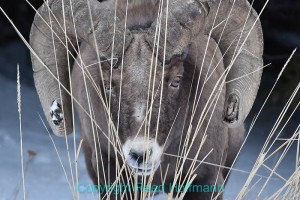
What makes this shot work is the one eye clearly visible through the stalks of grass. The viewer’s eyes are drawn immediately to it. Nikon D750, Aperture Priority, ISO 800, 1/160 at f/6.3, EV -1.0, Nikon 200-400mm f/4 lens with TC-14 teleconverter at 550mm. Photo copyright Reed Hoffmann.
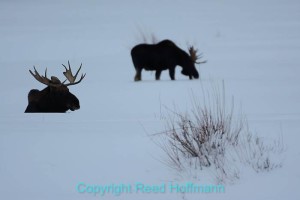
Notice that the focus is on the nearest moose, leaving the far one and the grasses at lower right out of focus. This again keeps the viewer’s attention returning to the one in focus. I also chose to use the D7100, a DX camera, instead of the D750 an FX, to take advantage of the internal cropping caused by the DX sensor size. Nikon D7100, Aperture Priority, ISO 250, 1/1000 at f/5.6, EV +0.7, Nikon 200-400mm f/4 lens with TC-14 teleconverter at 550mm. Photo copyright Reed Hoffmann.
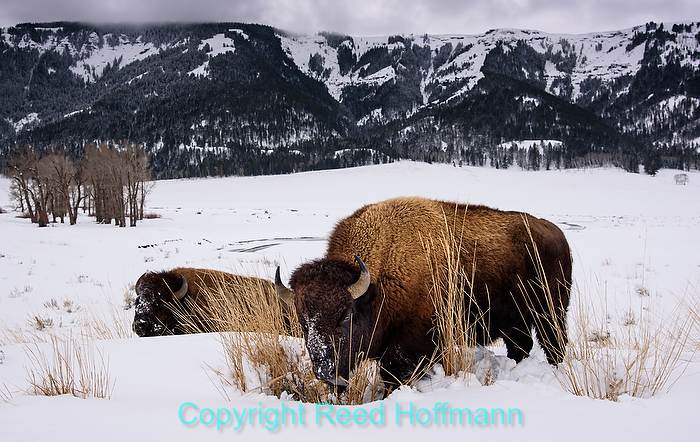
Normally you’d risk a fine and personal injury getting this close to bison, but in this case they’re just off a parking area, so we could shoot them from the car. And instead of a telephoto, I used a wide-angle to show the depth of the landscape they’re in. Finally, I’m applying some plus exposure compensation to make sure the snow retains it’s whiteness, instead of looking gray. This is something we’d do regularly when shooting in the snow. Nikon D750, Aperture Priority, ISO 250, 1/200 at f/7.1, EV +0.3, Nikon 24-120mm f/4 lens at 40mm. Photo copyright Reed Hoffmann.
I’ve always loved the patterns and color in the Travertine Terraces, which was just up the hill from the lodge at Mammoth. It’s easy to use a wide-angle lens there to include the whole scene, from the pools to the mountains. But most of my favorite photos came from concentrating on a smaller areas.
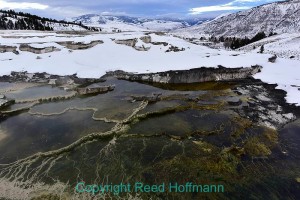
It’s easy to just shoot wide when you’ve got a landscape this interesting. But a better picture can sometimes be made if you look to the details, like the lines in this terrace in front of me. Nikon D750, Aperture Priority, ISO 200, 1/80 at f/5.6, EV -0.7, Nikon 20mm f/1.8 lens at 20mm. Photo copyright Reed Hoffmann.
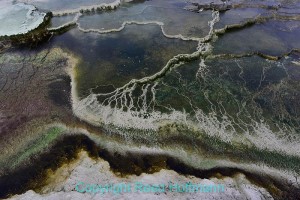
I thought this section of the terrace was more compelling by itself, reminding me of aerial photos of braided rivers and deltas. Nikon D750, Aperture Priority, ISO 200, 1/50 at f/5.6, EV -0.7, Nikon 20mm f/1.8 lens at 20mm. Photo copyright Reed Hoffmann.
Our first evening at the Old Faithful area, two of us were walking back to the lodge at dusk when we spotted a lone bison in a field behind the general store (closed for the winter). There wasn’t much light, but it was a great scene. Trying to avoid going too high with ISO to avoid noise, and at the same time going too low with shutter speed to avoid blur was a real challenge. That’s one of those times I’m so thankful for VR (Vibration Reduction, to lessen the chance for blur) and the ability to shoot hundreds of frames, if necessary, to get one good one.
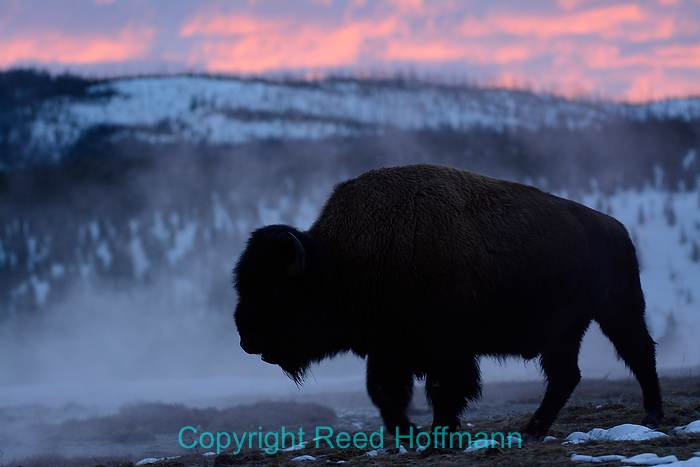
I could see this bison was walking in a direction that would soon have him silhouetted by the steam in the distance. So I moved to get ahead of him, then sat down on the ground. That low angle would bring the sunset down into the frame, and also give me a better chance to being steady enough – elbows braced on knees – to get a sharp picture at a fairly slow shutter speed. Nikon D7100, Aperture Priority, ISO 800,1/100 at f/4, EV -2.0, Nikon 200-400mm f/4 lens at 200mm. Photo copyright Reed Hoffmann.
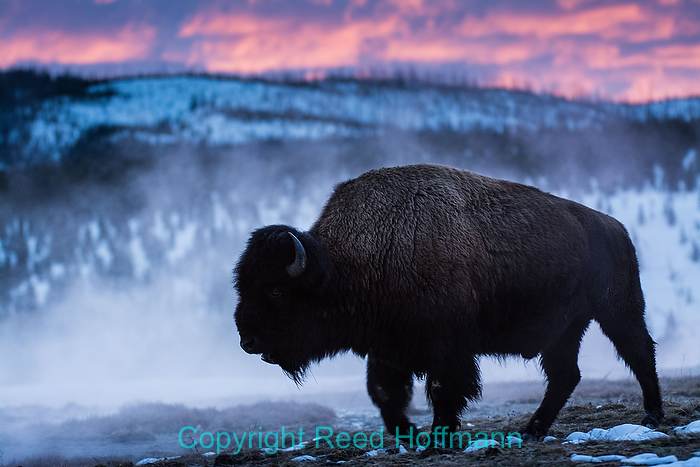
I take great pleasure in “making” photos, but am always happy if I can use editing software to add more impact. In this case I took the previous photo (a Nikon RAW file, NEF) into Adobe Photoshop’s ACR module to add contrast, bring out more detail in the bison’s coat, brighten the steam behind him and darken the sunset. Nikon D7100, Aperture Priority, ISO 800,1/100 at f/4, EV -2.0, Nikon 200-400mm f/4 lens at 200mm. Photo copyright Reed Hoffmann.
We also went out to do some light painting two nights. That means heading out after dark with a flashlight (or two or three) to use those lights to “paint” our subject. In the geyser basin we chose one of the more iconic geysers, Castle, and took turns using the flashlights to add light to it during long exposures. It was interesting how our two different lights created different color of light, a reminder that all light has color, and we often don’t see that with our eyes.
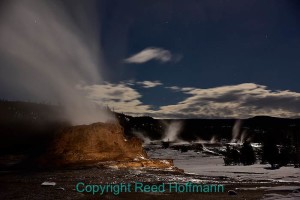
Twice during the trip we went out at night to do some light painting. This is a 20-second exposure of Castle Geyser, and I’m painting light on it from the far right with a small flashlight. I was able to narrow the beam of the light by creating a tube out a tissue box. Nikon D750, Manual, ISO 500, 20 at f/5, EV -2.0, Nikon 24-120mm f/4 lens at 55mm. Photo copyright Reed Hoffmann.
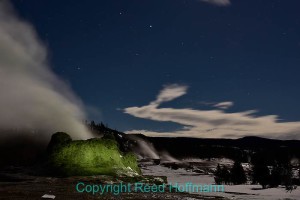
This is the same scene, but what changed was the flashlight. This time we used a different one, and note how that changed the color of the geyser. In both photos, the camera was set to Daylight white balance. NIKON D750, Manual, ISO 500, 15 at f/4.5, EV -2.0, Nikon 24-120mm f/1.8 lens at 38mm. Photo copyright Reed Hoffmann.
There were also a few times where a graduated neutral density filter came in handy. That’s a filter you put in front of the lens that gradually gets darker from one edge to the other. It allows you to reduce the amount of light in an overly bright area in the scene, which will help you get a better exposure (and more importantly, a better picture!).
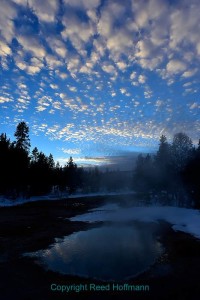
Here, the sky was so much brighter than the geyser pool in the foreground that it created an exposure problem, making it hard to difficult to see the water and the steam. Nikon D750, Aperture Priority, ISO 125, 1/160 at f/5.6, EV -0.3, Nikon 20mm f/1.8 lens. Photo copyright Reed Hoffmann.
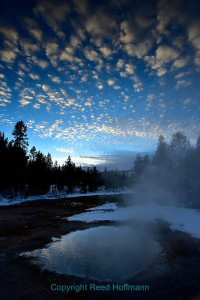
By putting a graduated neutral density filter in front of the lens, I was able to darken the sky, which also allowed he water and steam to be more visible.
Nikon D750, Aperture Priority, ISO 125, 1/80 at f/5.6, EV -0.3, Nikon 20mm f/1.8 lens. Photo copyright Reed Hoffmann.
On the sunny days, the skies were so deep blue that a polarizing filter wasn’t needed. It would actually have made them TOO dark. But we saw a couple of geysers firing, with the resulting water creating “mistbows,” what we’d call rainbows. A polarizing filter can help make a rainbow more visible, so that was a good time to use the one in the bag.
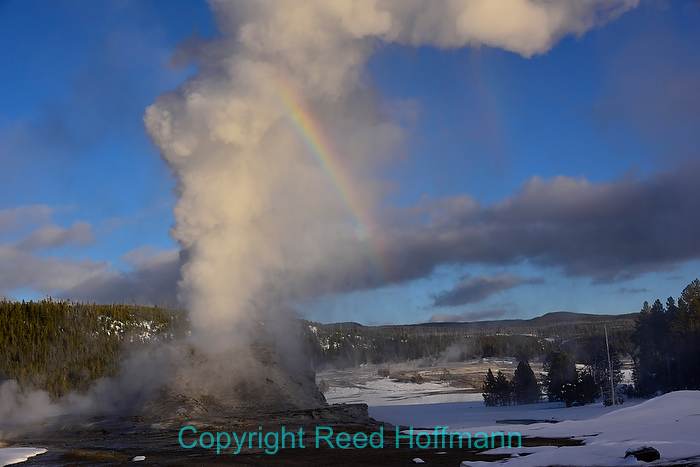
While Castle Geyser was erupting, the water spraying out formed rainbows (called “mist bows” there). The problem was, they were fairly faint, so I added a polarizing filter, which helped them show up better. Nikon D750, Aperture Priority, ISO 200, 1/500 at f/8, EV 0.0, Nikon 24-120mm f/4 lens at 44mm. Photo copyright Reed Hoffmann.
People often think of close-up photos as having to be done with close-up (micro, or macro) lenses. But many of our telephoto lenses today will focus very close, so I’ll often use one of those. That’s especially handy if you can’t get very close to the subject. And if I can get close, I’ll often use a wide-angle lens, to make that small subject look larger, and include some of the surrounding area.
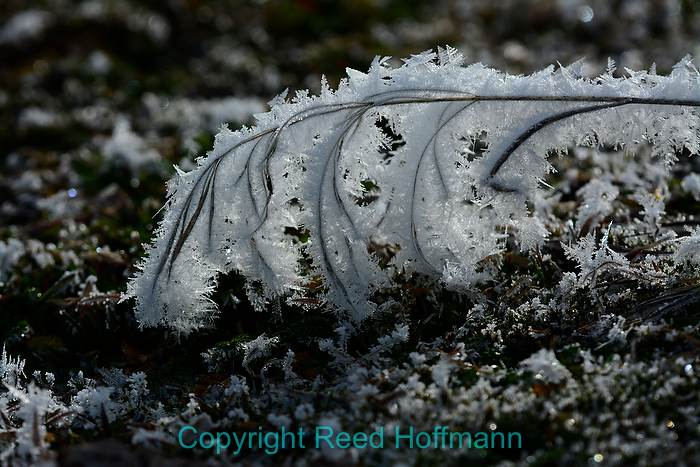
I loved the frost feathers coming off this plant, but couldn’t get close because it was in a restricted area. So I used my DX camera and lens at 400mm, which gave me an equivalent focal length of 560mm to shoot this close-up from ten feet away, Nikon D7100, Aperture Priority, ISO 250, 1/800 at f/9, EV -1.0, Nikon 200-400mm f/4 lens at 400mm. Photo copyright Reed Hoffmann.
Having sunlight coming through fog in trees creates shaft of light, and makes for a magical picture. As we approached Grotto Geyser, the amount of steam coming out of it, combined with a breeze carrying it west, made for a wonderful few minutes of shooting sunrays.
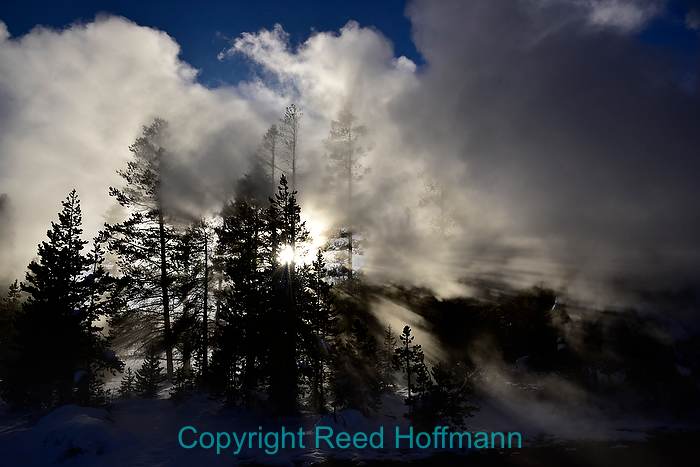
This was just being in the right place at the right time. With steam from a nearby geyser was blowing west into the trees, the shafts of light passing through the limbs made for a beautiful photo. Nikon D750, Aperture Priority, ISO 200, 1/400 at f/16, EV -0.3, 24-120mm f/4 lens at 24mm. Photo copyright Reed Hoffmann.
Yellowstone National Park has always been one of my favorite places in the U.S., and I’ve been lucky to visit there many times, in both summer and fall. But winter took its abundant exotic landscapes and wildlife to a whole new level. We had a great group and were lucky with the weather (snow, clouds and sun, but not brutally cold). Now I can’t wait for my next visit!
(if you’re interesting in joining me on a wildlife trip this year, I’ve got a few spots left on two great ones coming up – the Galapagos islands of Ecuador in April, and Tanzania in June. Drop me a note if you’re interested, but don’t wait too long – these usually sell out. And you can always view all the workshops I’m teaching here.)

